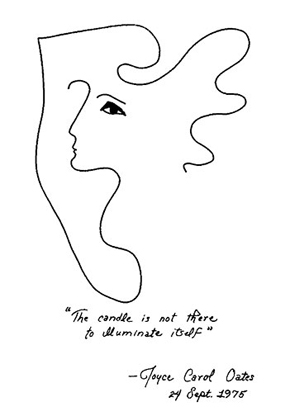Joyce Carol Oates: ‘Where Are You Going, Where Have You Been?’
by Karin Salvalaggio
Drawing by Joyce Carol Oates courtesy Celestial Timepiece, University of San Francisco
Anyone who doubts a short story’s capacity to pack a powerful punch hasn’t yet read the much anthologised and analysed short story by Joyce Carol Oates ‘Where Are You Going, Where Have You Been?’. Set in the mid-1960s, it is a tale that can be read as a crime story, an allegory, a snapshot of a shifting culture, a moral parable and a statement on feminism. Music threads through the prose, grounding it in a time when the worship of God was quickly giving way to the worship of popular culture. Tellingly, Oates dedicated this short story to Bob Dylan, stating that her inspiration was the song, ‘It’s All Over Now, Baby Blue’. Based on a real-life serial killer named Charles Schmid, the piece is a fictionalised account of a teenage girl’s abduction played out against the backdrop of post-war America’s transition into a more turbulent cultural and social age.
Connie is a pretty teenager on the cusp of adulthood who is experimenting with both her identity and her sexuality. In the moment “she sucked in her breath with the pure pleasure of being alive”, and is therefore at her most desirable, she attracts the attention of one of the most chilling antagonists ever depicted in fiction, Arnold Friend. You only have to take away the letter ‘r’ and you see Arnold Friend for who he really is – an old fiend. Connie is the ‘maiden’ and he is ‘death’ poised to whisk her away just when she is at the height of her beauty.
Connie cannot have it all. High-minded feminist principles won’t protect our daughters from predators, and Oates offers neither solutions nor apologies.”
It’s an allegorical tale that has been retold countless times but in the retelling, Oates highlights a serious barrier to the advancement of women’s rights. Although women’s roles are changing we are still vulnerable and it is not just predators and old fiends that we should fear. Connie identifies too heavily with popular myths disseminated through music and film that heavily emphasise beauty and romance – “she knew she was pretty and that was everything”. Her character is only a reflection of how others view her. She constantly has to check her image in the mirror to be assured. She judges the success of a night out by the amount of attention she receives from boys. When caught in the fragmented reflection of Arnold Friend’s mirrored sunglasses she is incapable of generating an identity strong enough to stand up to him. He defines who she is and controls what she does. Under his gaze, Connie’s life is distilled down to two stark choices. She either retreats to her “asbestos ranch house”, where she will have to grow “chunky and steady” like her sister in order to survive, or she puts herself at the mercy of a man and suffers an undisclosed fate. In reality, Connie cannot have it all. New freedoms come with hidden dangers. High-minded feminist principles won’t protect our daughters from predators and in the text Oates offers neither solutions nor apologies.
The chilling second half of the story plays out on the front steps of Connie’s family home. It’s a hot Sunday afternoon and Connie is alone. Following a nap in the sun, she is startled to find that her home appears to have shrunk. She retreats to her airless room where she finds solace in the music playing on a local radio station. When she hears a car coming up the drive she is only alarmed about her appearance. At first she doesn’t see Arnold Friend and his companion for who they really are. She is ill at ease, but then relaxes when she realises they’re listening to the same music. Arnold appears to be of similar age and makes references to pop culture that are familiar to her. He plays to Connie’s vanity, and when that doesn’t work he unnerves her by demonstrating an intimate knowledge of her personal life. Friends who were previously unnamed are identified. Her family’s whereabouts are fully explained. He knows nobody is coming home for her and implies that they had planned a Sunday drive together and it is she who is being uncooperative. Instead of standing up to him she plays along, but as the conversation continues Connie begins to notice odd things about Arnold. He wears a wig and the heels of his cowboy boots are stuffed with paper to make him appear taller. He mixes up cultural references and most alarmingly he and his friend are much older than she originally thought. Mild flirtation gives way to fear. His tone remains calm, but his words become both overtly sexual and violent.
This is the dark face of Connie’s sexual awakening. This is not the sort of romantic love she envisioned. She threatens to call the police, but Arnold assures her that resistance is futile. He even promises to stay outside as long as she doesn’t call for help. In the end Connie is undone by her love for her family. He will spare them if she comes willingly. Unlike the first half of the story, which has very little dialogue, her encounter with Arnold Friend is played out in a lengthy conversation. For the first time we finally hear Connie’s voice and see her for what she really is. Like many teenagers, “everything about her [character] has two sides”, one that she displays for her peers and the other she saves for her family. Without these fixed reference points Connie’s character fragments further. In the end her character’s point of view separates completely and it’s Connie who describes herself in third person – “She watched herself push the door slowly open as if she were back safe somewhere in the other doorway, watching this body and this head of long hair moving out into the sunlight where Arnold Friend waited.”
‘Where Are You Going? Where Have You Been?’ is a haunting tale that forces the reader to confront so many of life’s ambiguities, and at a little over 5,000 words it is more impactful than most full-length novels. A masterclass in storytelling, I’ve revisited it countless times and like much of Joyce Carol Oates’s work, it has heavily influenced my own writing.
Karin Salvalaggio was born in West Virginia and raised in an Air Force family, growing up on a number of military bases around the US and overseas. She lives in London with her two children and recently completed an MA in Creative Writing at Birkbeck, University of London. Her debut novel Bone Dust White, a suspenseful thriller about abandonment and dark family secrets, will be published in the US by Minotaur Books in May 2014. Rights have also been sold in Germany and Italy.
“As jarring as a headfirst plunge in an icy river, Bone Dust White is a stark and unforgettable reading experience; its ambience, like the bruised people whose twisted lives it traces, is chilly – and irresistible.”
Julia Keller, author of A Killing in the Hills
Author portrait © Ross Ferguson Photography
karinsalvalaggio.com
Read ‘Where Are You Going? Where Have You Been?’ at Celestial Timepiece, the Joyce Carol Oates pages of the University of San Francisco.
‘Where Are You Going? Where Have You Been?’ was first published in Epoch in 1966 and subsequently appeared in The Best American Short Stories (1967), Prize Stories: O. Henry Award Winners (1968) and other collections, including High Lonesome: New & Selected Stories, 1966–2006, published by Harper Perennial.


